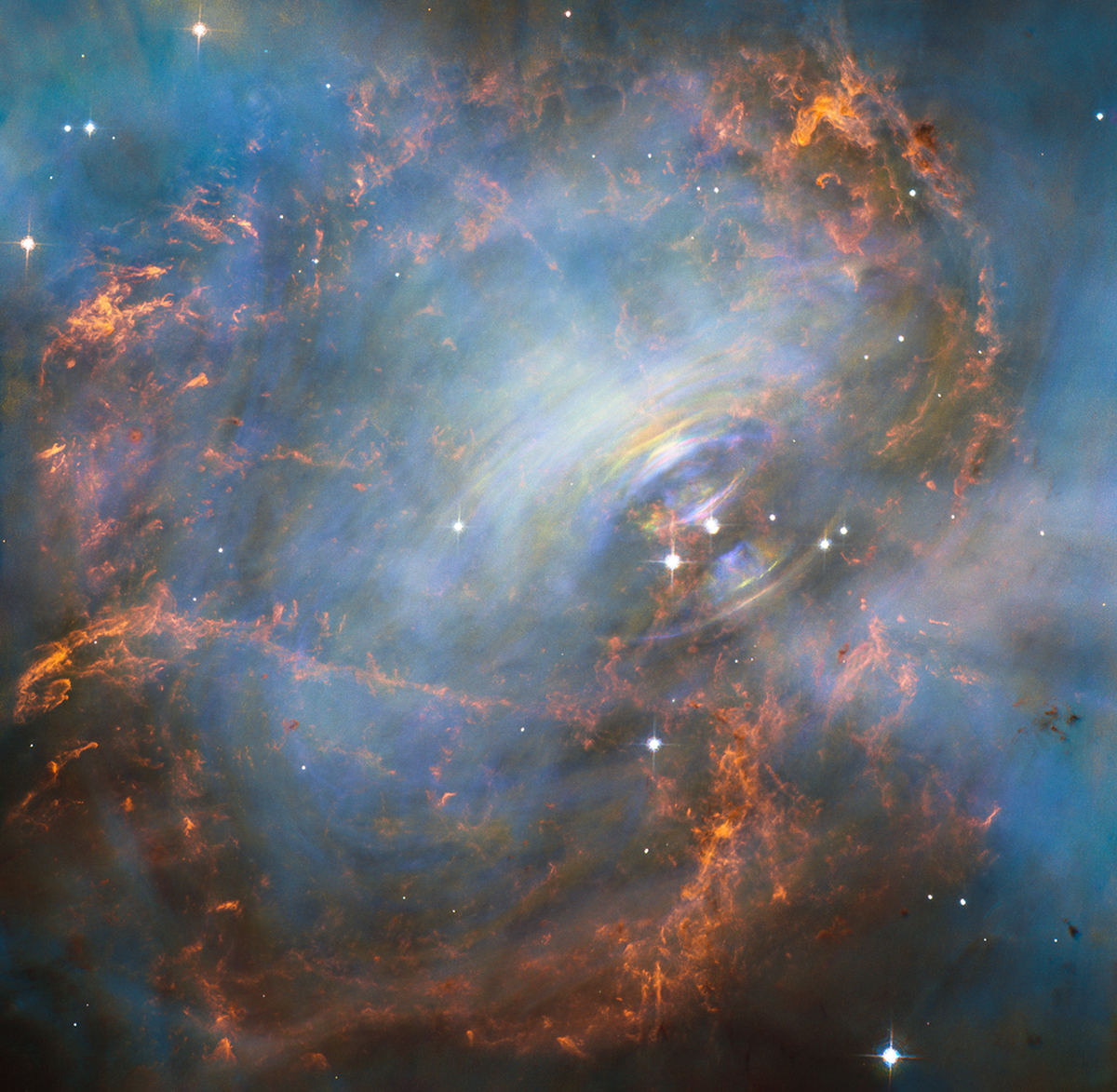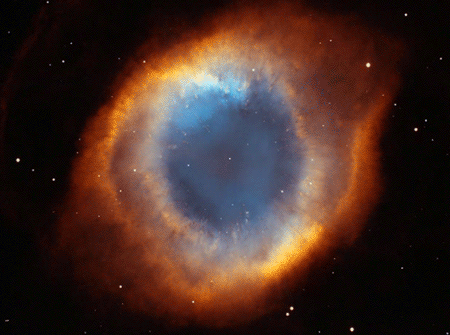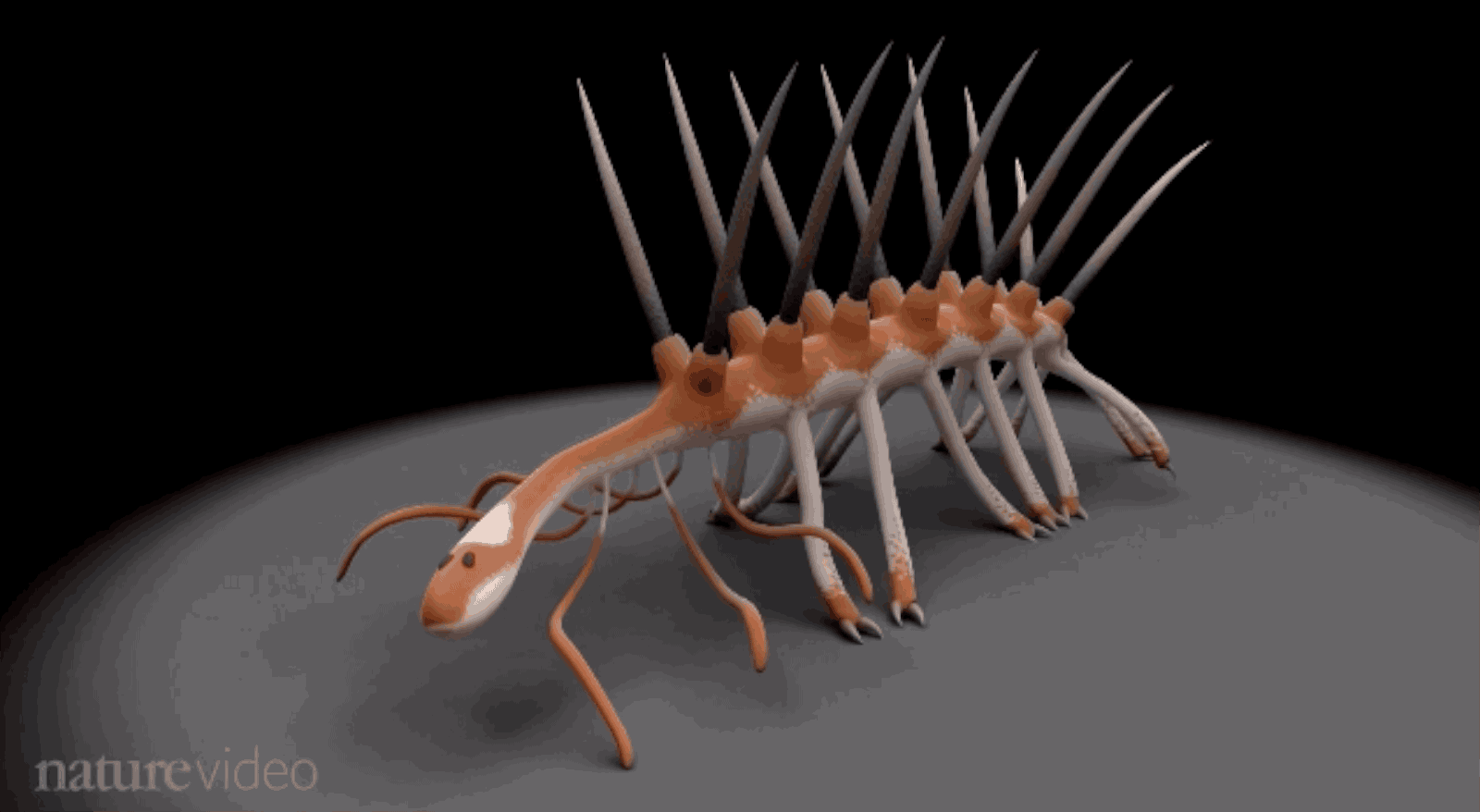https://www.sciencedaily.com/releases/2017/01/170105100936.htm

Originally shared by NASA Goddard
Peering deep into the core of the Crab Nebula, this close-up image reveals the beating heart of one of the most historic and intensively studied remnants of a supernova, an exploding star. The inner region sends out clock-like pulses of radiation and tsunamis of charged particles embedded in magnetic fields.
The neutron star at the very center of the Crab Nebula has about the same mass as the sun but compressed into an incredibly dense sphere that is only a few miles across. Spinning 30 times a second, the neutron star shoots out detectable beams of energy that make it look like it’s pulsating.
The NASA Hubble Space Telescope snapshot is centered on the region around the neutron star (the rightmost of the two bright stars near the center of this image) and the expanding, tattered, filamentary debris surrounding it. Hubble’s sharp view captures the intricate details of glowing gas, shown in red, that forms a swirling medley of cavities and filaments. Inside this shell is a ghostly blue glow that is radiation given off by electrons spiraling at nearly the speed of light in the powerful magnetic field around the crushed stellar core.
The neutron star is a showcase for extreme physical processes and unimaginable cosmic violence. Bright wisps are moving outward from the neutron star at half the speed of light to form an expanding ring. It is thought that these wisps originate from a shock wave that turns the high-speed wind from the neutron star into extremely energetic particles.
When this “heartbeat” radiation signature was first discovered in 1968, astronomers realized they had discovered a new type of astronomical object. Now astronomers know it’s the archetype of a class of supernova remnants called pulsars – or rapidly spinning neutron stars. These interstellar “lighthouse beacons” are invaluable for doing observational experiments on a variety of astronomical phenomena, including measuring gravity waves.
Observations of the Crab supernova were recorded by Chinese astronomers in 1054 A.D. The nebula, bright enough to be visible in amateur telescopes, is located 6,500 light-years away in the constellation Taurus.
Credits: NASA and ESA, Acknowledgment: J. Hester (ASU) and M. Weisskopf (NASA/MSFC)
 <
<
Originally shared by Corina Marinescu
Strokkur Geyser – Iceland
A geyser is the result of high-temperature steam rising up from cooling magma beneath, which causes an eruption of water.
Eruptions usually occur with intervals of between 5-10 minutes and involve a single burst reaching a height of up to 30 meters, although occasionally up to 5 bursts in relatively quick succession are observed. Prior to eruptions, the pool is full and gently pulsates up and down. The eruption commences when a pulse of steam rising from below pushes the water in the pool upwards forming a large dome (or bubble) of water through which the steam bursts and expels much of the water in the pool skywards.
Reference:
http://www.photovolcanica.com/VolcanoInfo/StrokkurGeyser/StrokkurGeyser.html

“The Horsehead Nebula in Infrared from Hubble ” is NASA’s Astronomy Picture of the Day:

Move across Helix Nebula
A counterclockwise zoom and rotation sequence of the Helix Nebula. The Hubble’s Advanced Camera for Surveys image of the Helix Nebula reveals thousands of comet-like filaments embedded along the inner rim of the nebula that point back towards the central star.
► Credit: NASA, The Hubble Helix Team and G. Bacon (STScI)
► The animation below comes from a NASA video “Move across Helix Nebula”, that you can watch here>>
http://hubblesite.org/newscenter/archive/releases/2003/11/video/c/
Helix Nebula, also known as NGC 7293, located at a distance of about 700 light-years in the constellation Aquarius, is one of the nearest planetary nebulae to Earth.
This bright and large planetary nebula was discovered by Karl Ludwig Harding, probably before 1824.
It is similar in appearance to the Cat’s Eye Nebula and the Ring Nebula, whose size, age, and physical characteristics are similar to the Dumbbell Nebula, varying only in its relative proximity and the appearance from the equatorial viewing angle.
The Helix Nebula has sometimes been referred to as the “Eye of God” in pop culture, as well as the “Eye of Sauron”.
The Helix Nebula is an example of a planetary nebula, or ‘nebula’ formed at the end of a star’s evolution. Gases from the star in the surrounding space appear, from our vantage point, as if we are looking down a helix structure. The remnant central stellar core, known as a planetary nebula nucleus or PNN, is destined to become a white dwarf star. The observed glow of the central star is so energetic that it causes the previously expelled gases to brightly fluoresce.
The Helix Nebula was also the first planetary nebula discovered to contain cometary knots. More than 20,000 of them are estimated to be in this interesting nebula. Their origins are still not well understood.
Further reading and references
► https://en.wikipedia.org/wiki/Helix_Nebula
► http://apod.nasa.gov/apod/ap080413.html
► http://www.noao.edu/jacoby/pn_gallery.html
► http://hubblesite.org/newscenter/archive/releases/1996/13/image/a/

A brilliant riff on a fascinating paper…
Originally shared by Brian Koberlein
The Fading Truth
By some estimates the rogue world has been cold for about 100 billion years. What atmosphere it once had was long gone, and for most of its life the world sailed between the starry sea of the supergalaxy. But for the first few billion years of its existence it had orbited a star. Under the warmth of a sun, life arose. Remnants of life on the world are faint, but unmistakable. And then there is the beacon….
The rest is at https://briankoberlein.com/2016/06/02/the-fading-truth/

A reconstruction of Hallucigenia’s walking gait, created by Lars Fields.
“Hallucigenia were tiny marine worms — commonly just 15 millimeters in length — that lived in the Cambrian period, when complex, multicellular life was starting to populate the Earth….”
https://www.livescience.com/51331-bizarre-ancient-worm-face-revealed.html

Originally shared by Corina Marinescu
The Value of Science
Richard Feynman included a poem in his address to the National Academy of Sciences:
I stand at the seashore, alone, and start to think.
There are the rushing waves
mountains of molecules
each stupidly minding its own business
trillions apart
yet forming white surf in unison
Ages on ages
before any eyes could see
year after year
thunderously pounding the shore as now.
For whom, for what?
On a dead planet
with no life to entertain.
Never at rest
tortured by energy
wasted prodigiously by the Sun
poured into space.
A mite makes the sea roar.
Deep in the sea
all molecules repeat
the patterns of one another
till complex new ones are formed.
They make others like themselves
and a new dance starts.
Growing in size and complexity
living things
masses of atoms
DNA, protein
dancing a pattern ever more intricate.
Out of the cradle
onto dry land
here it is standing:
atoms with consciousness;
matter with curiosity.
Stands at the sea,
wonders at wondering: I
a universe of atoms
an atom in the Universe
Source:
http://www.math.ucla.edu/~mwilliams/pdf/feynman.pdf
Photo source: